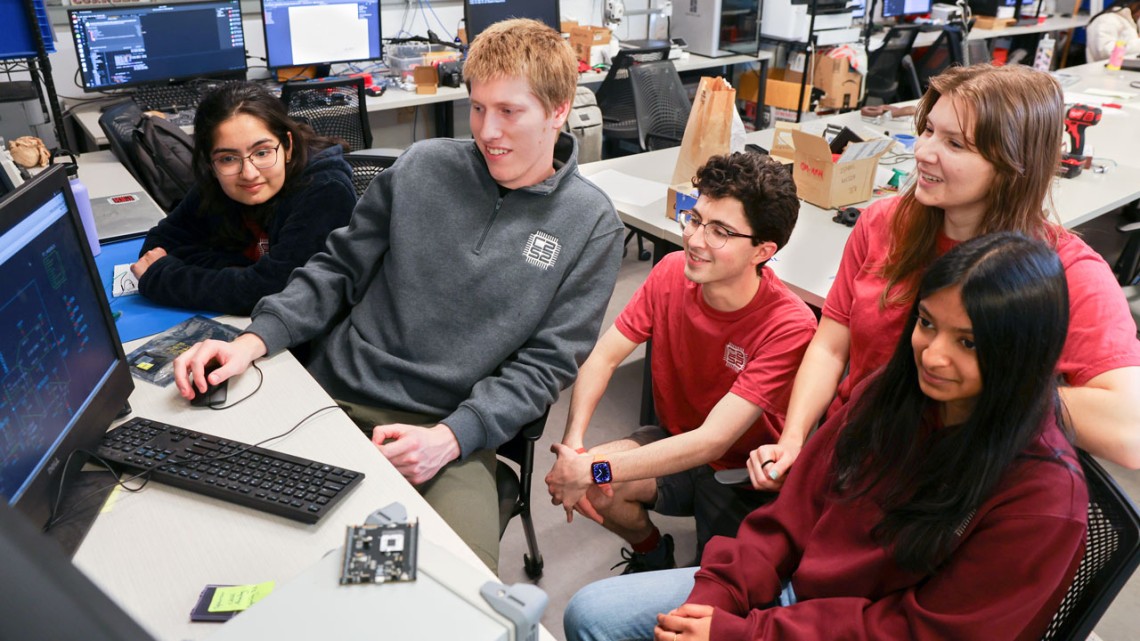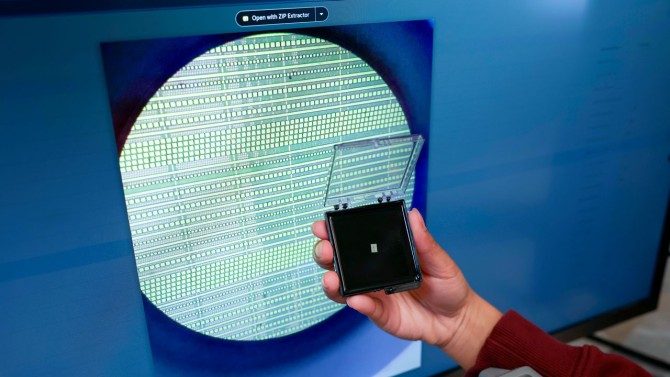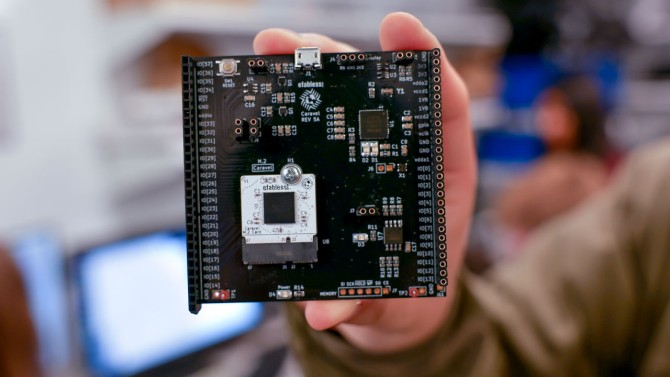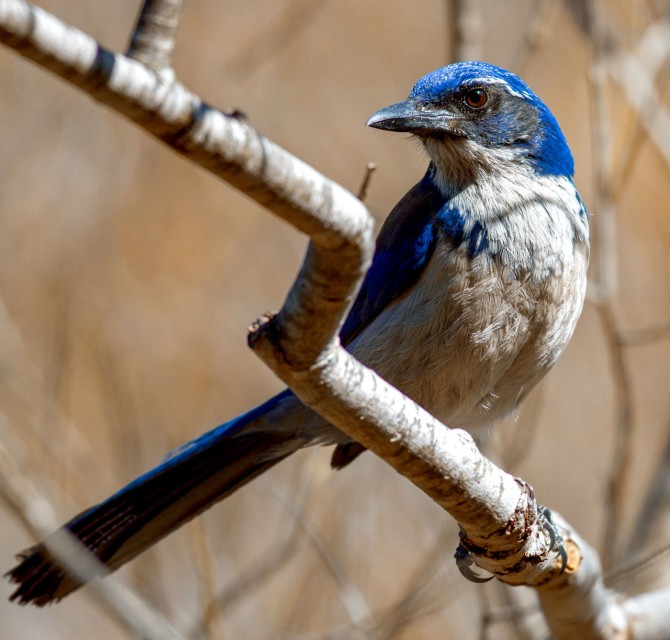
Akshati Vaishnav ’25 (left to right), Thomas Figura ’24, Aidan McNay ’24, Adele Thompson ’25 and Abigail Varghese ’25 are members of the Cornell Custom Silicon Systems team, which uses emerging open-source hardware to design, test and fabricate microchips.
Students revive classic microchip fabrication with open-source tools
By David Nutt, Cornell Chronicle
Microchips drive so many essential electronics, from appliances to airplanes, it is easy to take them for granted. But they are not easy to make.
For the past two years, a unique project team has enabled Cornell undergraduates to use emerging open-source hardware to design, test and fabricate their own microchips – a complex and expensive process that is rarely, if ever, available to students.
Undergrads aren’t the only ones to benefit. The team, Cornell Custom Silicon Systems (C2S2), has been collaborating with a researcher in the Cornell Lab of Ornithology to create a custom lightweight, low-power microchip that can tag female corvids – a family of birds including crows, ravens and jays – and record their vocalizations.
“So much has been rapidly evolving,” said team lead and co-founder Aidan McNay ’24. “I think most companies would not have a finalized chip design within two years. And at this point, we’ve almost taped out four chips, which is a testament to the team members. It’s amazing how much they learn and pick up.”
Like a microchip itself, the origin of C2S2 has many layers. The team initially was formed by students of Christopher Batten, professor in electrical and computer engineering in Cornell Engineering. But it didn’t happen overnight. More like a decade.
When Batten came to Cornell in 2010, he explored launching a chip-design project team for students but ultimately decided it was just not possible.
“There were many challenges at the time with undergraduate students independently working on chip design,” Batten said. “The commercial chip-design tools are complex and hard to use; there are complex legal agreements with semiconductor foundries making it difficult to share and collaborate; the students would have to develop everything from scratch; and it can be expensive to fabricate chips even in older technologies.”
Originally, the heart of chip design and fabrication was an anachronistic process called the “tape out,” which involved storing detailed instructions on magnetic tape that would be shipped to a commercial foundry. (Now, the files are uploaded online, but the musty nomenclature remains.) Batten teaches an advanced course for seniors and graduate students that has all of the elements of chip design – layout, modeling, characterization – without any tape out, and therefore, no physical chip.
“The students don’t get the experiential learning aspect,” said Batten, who is a faculty adviser for C2S2, along with lecturer Hunter Adams. “They don’t get silicon in their hand, and they don’t actually make anything. They just simulate it. But for many years, this is the best we could really do.”
‘Mind blowingly complicated and cool’
In spring 2022, McNay was a sophomore in Batten’s research group, focusing on software profiling, but he wanted to pivot to hardware. When he and Batten learned the Shen Fund for Social Impact was offering annual $30,000 grants for new project teams, they decided to write up a proposal for a student chip-design team, one that had a modern advantage over past efforts: the emergence of open-source technology, which allows users to circumvent the onerous cost, tool and legal issues. The proposal specified that the students would collaborate with a campus partner to demonstrate the research impact of custom-made silicon.
“We noticed a lack of undergraduate preparation in the field,” McNay said. “Most students experience chip design and research either late in academia at a graduate level or when they first get into industry. With the growing needs on the semiconductor industry, we probably don’t want to wait that long to engage undergraduates in this design field.”
Getting undergraduates onboard early, as freshmen, would be essential.
“By the time they’re seniors, it’s too late, they all want to be web app developers or write machine-learning software,” Batten said. “But the idea that freshmen can be involved in chip tape outs defies conventional wisdom. The chip computer industry has done a fantastic job of explaining and complaining how hard it is to do chip design. Clearly, freshmen can’t do something that hard – that’s basically what everybody’s been telling students for years.”
To prove otherwise, McNay and Batten looked to the wide range of student project groups that are “mind blowingly complicated and cool” – from the Cornell Rocketry team, which McNay was involved with from 2021 to 2023, to the Cornell University Autonomous Underwater Vehicle and Cornell Mars Rover teams.
Abigail Varghese ’25 learned about C2S2 when Batten visited her ENGRI 1210: The Computing Technology Inside Your Smartphone class and pitched the students on the team. She hadn’t decided on a major yet, but she was intrigued by the concept, even though she hadn’t done much tech design work herself.
“I was learning more about computer engineering and I really wanted the opportunity to have a project to work on that I could actually see how the theories I’d be learning in classes could be applied, rather than just getting a normal problem set and not really knowing how to apply it afterwards,” she said.
Since joining last year, Varghese has enjoyed watching the team develop through collaboration, with upperclassmen sharing what they’ve learned with new members.
“It is really cool to see that passage of knowledge and really seeing how anyone, as long as they’re interested and willing to put in effort and work together, can tape out,” she said.
C2S2 now has 25 members, ranging from freshmen to seniors, in a variety of majors, including electrical and computer engineering, computer science, engineering physics, mathematics and applied economics and management. The students are grouped into five subteams: digital, analog, software, system architecture and project management.
Varghese leads the project management subteam, and she’s already put those skills into practice outside of Cornell, interning with Boeing over the summer.
“It was a completely new field, the aerospace side, that was unfamiliar for me,” she said. “But one of the biggest comments I got was, ‘Wow, you’re really good at picking things up on the fly.’ It’s something I definitely learned to develop from talking with the team, hearing about the projects they’ve been working on and understanding their projects well enough to share with others who may not have experience with chip design.”
Each subteam focuses on a different facet of the same overarching project, which they are developing over multiyear iterations, adding more and more complexity each round. Creating a microchip not only requires close planning and coordination across the subteams, it also requires a great deal of reviewing, testing, troubleshooting and – perhaps more than anything – time.
The team tapes out a chip each spring and sends it off to the foundry to get fabricated. C2S2 works with a company called Efabless that serves as a middleman of sorts with the large domestic foundry SkyWater. Efabless orders a limited run of chips and carves off a portion – roughly 40 – for C2S2. Each tape out costs about $10,000 – a pittance in the chip fabrication world.
C2S2 receives the completed chips in mid-to-late fall, and then they test them. However, just because a chip has been fabricated does not necessarily mean it is functional.
For their first tape out, last spring, C2S2 designed two different chips and both came back successful. It’s difficult to overstate how impressive that is, Batten said. Taping out a chip is hard. Taping out a chip that works is really, really hard. There’s so much that can go wrong.
“It’s not like software,” Batten said. “You build some software, it doesn’t work, you fix the software. Hardware, you tape out the chip, it doesn’t work, OK, good luck, you just wasted $10K. Let’s try again and take another year. That’s why testing before you tape out, being very careful and diligent, having ways to debug and understand the post-silicon is really important.”
‘This is gold’
A microchip is only as successful as its application. C2S2 sought out a campus partner whose research could benefit from a small embedded system. They connected with Christopher Tarango, a doctoral candidate in the Department of Ecology and Evolutionary Biology who specializes in the female-specific vocalization of corvids – research that is usually done at a distance and already requires technical assistance.
“Trying traditional methods of going out and standing and staring at the birds with a handheld microphone and trying to observe them give that call in a natural way, meaning not using any kind of stimulus or playback, to elicit them to vocalize more, was prohibitively time-consuming,” Tarango said.
Previously, Tarango had been capturing birds, attaching temporary, tiny backpack devices and releasing the birds to record their intermittent vocalizations without hampering their natural behavior, but those devices were too cumbersome for all scrub jay species. The ideal tag shouldn’t weigh more than 3-5% of an animal’s body weight, and Tarango wanted to prioritize the bird’s safety.
The C2S2 team volunteered to create a more versatile, lightweight, power-efficient microchip that could record and classify the vocalizations while also tracking the birds’ movements with motion sensors so Tarango could determine what the birds were doing while calling. The technology could be used for studying the behavior of other small animals, such as bats and rodents, as well.
Tarango gave the team his specifications and requirements and periodically checks in to see how the project is progressing. He has been impressed with what he’s seen.
“Experiential learning is something that I’m a strong proponent of, and so being able to see them do it and being able to advise and be a part of it, and just watch them grow as scientists and as communicators has been truly fantastic,” he said.
Each tape out adds a little more functionality, such as capturing microphone input and classifying noises, but those features have not been integrated on the same chip yet. There is also a plan to integrate analog and digital components, which is a difficult task even for seasoned chip builders.
Tarango is not the only one who has been impressed by the team’s efforts.
“I have to say, this is gold,” Batten said. “The idea that you can have students engaging with a customer or client to understand specifications or requirements, and then tailor a system to meet those specification requirements, it’s so engaging and applied in a way that the classroom just can’t reproduce.”
As unique as the team is, Batten emphasizes, it’s also a lot of work.
“This is a legitimate hands-on student-driven experiential learning experience, which is hard,” he said. “But if you put in the work, you are going to get real silicon. And there’s very few undergraduates that can say that.”
C2S2 has already gained industry sponsors, including AMD and Cadence, some of which were facilitated by team alumni who have remained in touch, often sharing tips about the tools they’ve developed and offering advice.
McNay is graduating this spring, but he plans to remain at Cornell for a Master of Engineering degree. Like the other members, he’s earned course credit for C2S2. But that was just a nice bonus.
“A lot of members choose to pursue C2S2 just because it’s really cool and they find it interesting to work on,” McNay said. “When you come home at the end of the day, what are you still thinking about? I know I’m still thinking about C2S2. I’m wondering, Can I do that? Maybe.”
Media Contact
Get Cornell news delivered right to your inbox.
Subscribe



